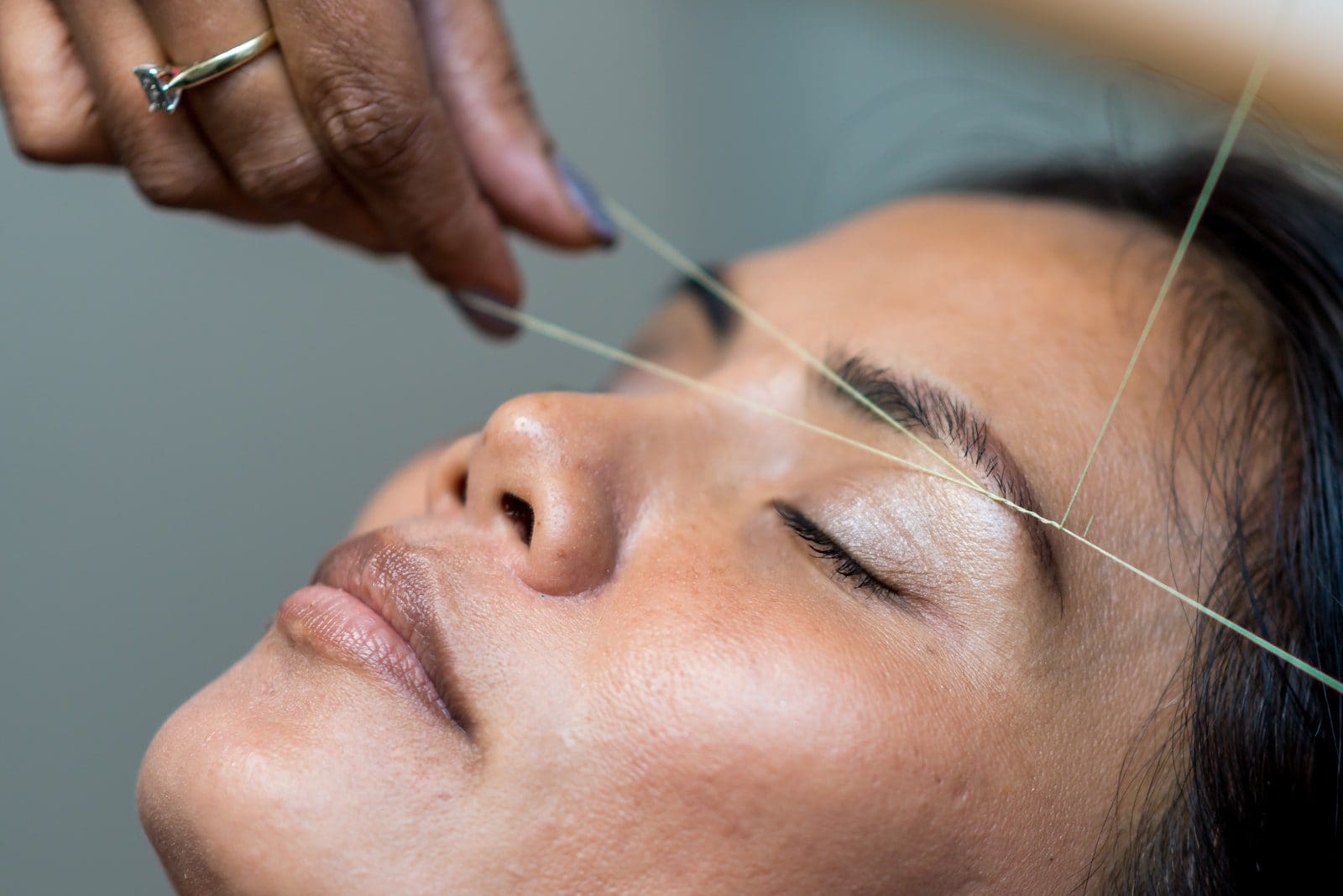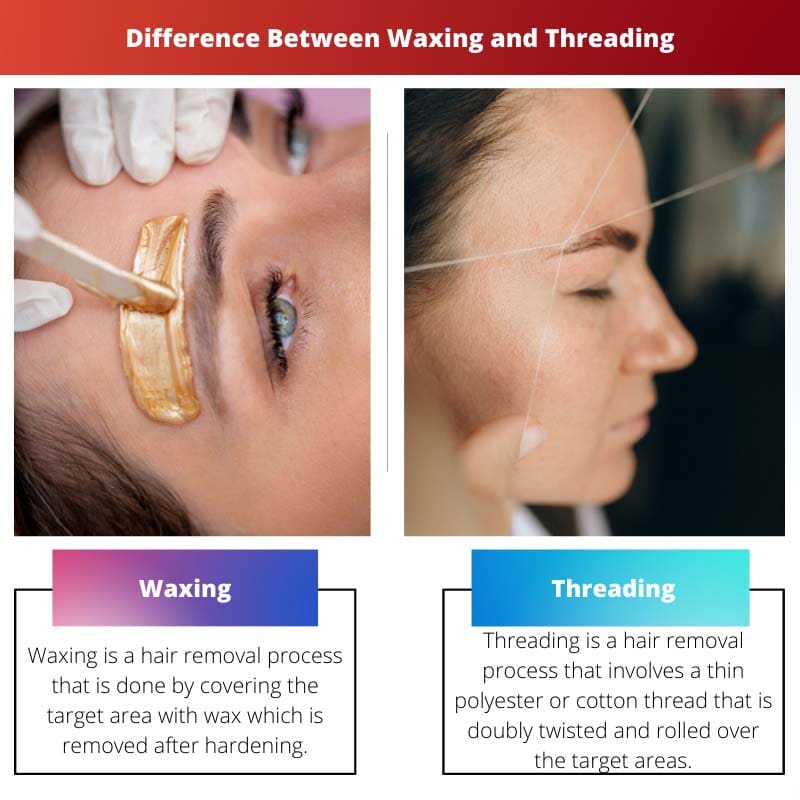The process of hair removal has been practiced for ages. Initially, it was used to eradicate lice and reduce body odor, which accumulated on the body hair.
Regular removal of body hair is crucial to maintain hygiene in the body. The two most common hair removal processes are waxing and threading.
Key Takeaways
- Waxing removes hair by applying warm wax and quickly pulling it off, taking hairs with it.
- Threading uses twisted cotton thread to pluck hairs from their follicles, providing precise hair removal.
- Both methods provide longer-lasting results than shaving, but waxing is faster while threading offers greater precision.
Waxing vs Threading
The difference between waxing and threading is that the process of waxing is done by a sticky substance which is known as wax, while the process of threading is done by a thin polyester or cotton thread that is doubled and twisted.

Waxing can further be classified into two types- strip waxing and stripless waxing. This process of hair removal is ideal for a larger area with coarse, thick, and rough hair. The process can have several side effects also.
While threading techniques can further be divided into three main types – hand, neck, and mouth.
This process of hair removal is suitable for a smaller area of hair removal. It is a natural process and mostly does not show any side effects.
Comparison Table
| Parameters of Comparison | Waxing | Threading |
|---|---|---|
| Definition | Waxing is a hair removal process that is done by covering the target area with wax which is removed after hardening | Threading is a hair removal process that involves a thin polyester or cotton thread that is doubly twisted and rolled over the target areas |
| Types | Waxing can further be divided into two types- strip waxing and stripless waxing | Techniques of threading can further be divided into three main types – hand method, neck method, and mouth method. |
| Area of application | Waxing is suitable for larger areas of hair removal | Threading is suitable for a smaller area of hair removal |
| Advantages | Waxing can remove a large area of hair at one time and the method is long-lasting as the regrowth of hair is not fast | Threading provides precision and is a fast process. It does not cause ingrown hairs and is a gentle process. It is suitable for all skin types. |
| Disadvantages | It is a painful process and can have side effects like red bumps, ingrown hair, Skin lifting, minor bleeding, and others | It can be a painful process and can cause folliculitis which is inflammation of the hair follicles |
What is Waxing?
Waxing refers to a process of hair removal. The waxing process is done by covering the target area with a sticky substance known as wax, which adheres to the hair.
And the wax is then removed, pulling out the hair from the follicle. A freshly waxed area does not experience hair growth for up to four to six weeks.
The most common area of the body which is waxed are eyebrows, arms, face, legs, pubic hair, back, feet, abdomen, and even knuckles.
Waxing can be further divided into two main types – strip waxing and stripless waxing. Strip waxing includes a thin layer of wax over the skin with a cloth or a paper strip.
Strip waxing is also known as soft waxing. Strip waxing can be done in heated, pre-made, or even cold strips.
Strip waxing is also known as hard waxing. The layer of wax is thick, and no paper or cloth strips are applied. It is removed after the wax cooling and hardening on the skin.
This technique is helpful for individuals with sensitive skin. The method is also comparatively less painful than strip waxing.
Waxing is an effective method as it removes the hair from its root. But the process can also lead to tearing the top layer of skin, known as skin lifting.
Other side effects include red bumps, ingrown hair, minor bleeding, and others. People with sensitive skin should avoid waxing. Waxing should always be performed under a licensed esthetician.

What is Threading?
Threading refers to a process of hair removal. The process of threading involves a thin polyester or cotton thread that is doubled and twisted, and rolled over the target areas to pull out unwanted hair from the follicle level.
It can remove short rows of hair at a time. The process is a skill-based task and requires a certified esthetician to carry out the process.
The origin of threading was in Iran and Central Asia, especially in India. Later it gained popularity in Western countries for cosmetic applications, particularly for eyebrow threading.
The technique of threading can be painful. However, the pain can be minimized by the correct application of pressure. Threading is considered a low-risk hair removal technique.
Threading techniques can further be divided into three main types – hand, neck, and mouth. The highest precision and the fastest method is the mouth method.
Threading is most commonly used for the removal of hair from the eyebrows, cheek, chin, upper lip area, or the entire face.
Threading in other areas like arms, feet, or legs is not recommended, as the regions have coarse hair in high amounts, which may be difficult to remove. The process of threading is also known as epilation.
Threading is a fast process and does not cause any ingrown hair. Since the technique does not involve any chemicals, it can also be used by sensitive skin types. However, areas with acne should always be avoided.

Main Differences Between Waxing and Threading
- Waxing is a time-consuming and long process, while threading is a fast and quick process.
- Eyebrow waxing does not provide enough precision and control in shaping the eyebrows, while eyebrow threading provides more precision and control.
- Waxing involves chemicals, while threading is a natural process and does not involve any chemicals.
- The process of waxing is done by a sticky substance which is known as wax, while the process of threading is done by a thin polyester or cotton thread which is doubled and twisted.
- Waxing is more painful, while threading is comparatively less painful with the correct application of pressure.

- https://www.tandfonline.com/doi/pdf/10.1080/09546634.2020.1793883
- https://journals.lww.com/dermatologicsurgery/Fulltext/2011/06280/Eyebrow_Epilation_by_Threading__An_Increasingly.26.aspx

I have never tried waxing but the whole process of pulling hair from the follicle with threading sounds horrific.
So, are they both equally as painful or is one less so than the other?
Threading is generally regarded as being less painful than waxing, but it can still vary from person to person.
They both sound painful, I don’t think I’ll be trying either of them anytime soon.
You’re probably right about that!
Threading seems like the perfect solution for me, as I’ve got very sensitive skin. I’ve only ever waxed my eyebrows, though; can’t wait to see the results!
That’s right! The precision of threading can’t be compared. I believe you’re going to love it!
So waxing is both more time-consuming and more painful than threading, and involves chemicals? I can’t wait to try it!
What a fantastic sales pitch!
Plus, the potential for skin tearing sounds promising.
Well I suppose this is useful information for someone who doesn’t know the difference between waxing and threading.
Absolutely, you’d be surprised at how many people don’t know that.